Nonlinear Optical Response of Gold Nanobipyramids for a Doubly Q-Switched Ho-Doped Laser at a Wavelength of 2.1 µm
Abstract
1. Introduction
2. Fabrication and Characteristics of the Au-NBP SA
3. Experimental Setup
4. Results and Discussions
5. Conclusions
Author Contributions
Funding
Data Availability Statement
Conflicts of Interest
References
- Mizutani, K.; Ishii, S.; Aoki, M.; Iwai, H.; Otsuka, R.; Fukuoka, H.; Isikawa, T.; Sato, A. 2 μm Doppler wind lidar with a Tm:fiber-laser-pumped Ho:YLF laser. Opt. Lett. 2018, 43, 202–205. [Google Scholar] [CrossRef]
- Duan, X.M.; Qian, C.P.; Shen, Y.J.; Su, L.B.; Zheng, L.H.; Li, L.J.; Yao, B.Q.; Dai, T.Y. Efficient Ho:(Sc0.5Y0.5)2SiO5 laser at 2.1 µm in-band pumped by Tm fiber laser. Opt. Express 2019, 27, 4522–4527. [Google Scholar] [CrossRef]
- Pominova, D.; Proydakova, V.; Romanishkin, I.; Ryabova, A.; Kuznetsov, S.; Uvarov, O.; Fedorov, P.; Loschenov, V. Temperature Sensing in the Short-Wave Infrared Spectral Region Using Core-Shell NaGdF4:Yb3+, Ho3+, Er3+@NaYF4 Nanothermometers. Nanomaterials 2020, 10, 1992. [Google Scholar] [CrossRef]
- Gower, M.C. Industrial applications of laser micromachining. Opt. Express 2000, 7, 56–67. [Google Scholar] [CrossRef] [PubMed]
- Li, G.Q.; Zhao, S.Z.; Yang, K.J.; Li, D.C.; Zou, J. Pulse shape symmetry and pulse width reduction in diode-pumped doubly Q-switched Nd:YVO4/KTP green laser with AO and GaAs. Opt. Express 2005, 13, 1178–1187. [Google Scholar] [CrossRef]
- Ghrib, M.; Berthe, L.; Mechbal, N.; Rébillat, M.; Guskov, M.; Ecault, R.; Bedreddine, N. Generation of controlled delaminations in composites using symmetrical laser shock configuration. Compos. Struct. 2017, 171, 286–297. [Google Scholar] [CrossRef]
- Zhang, X.Y.; Zhao, S.Z.; Wang, Q.P.; Ozygus, B.; Weber, H. Modeling of diode-pumped actively Q-switched lasers. IEEE J. Quantum Electron. 1999, 35, 1912–1918. [Google Scholar] [CrossRef]
- Paschotta, R. Understanding Passively Q-Switched Solid-State Lasers. Photon. Spectra 2014, 48, 55–57. [Google Scholar]
- Duan, X.M.; Yao, B.Q.; Yang, X.T.; Li, L.J.; Wang, T.H.; Ju, Y.L.; Wang, Y.Z.; Zhao, G.J.; Dong, Q. Room temperature efficient actively Q-switched Ho:YAP laser. Opt. Express 2009, 17, 4427–4432. [Google Scholar] [CrossRef]
- Li, E.H.; Tang, J.W.; Shen, Y.J.; Wang, F.; Wang, J.; Tang, D.Y.; Shen, D.Y. High Peak Power Acousto-Optically Q-Switched Ho:Y2O3 Ceramic Laser at 2117 nm. IEEE Photon. Technol. Lett. 2020, 32, 492–495. [Google Scholar] [CrossRef]
- Duan, X.M.; Shen, Y.J.; Gao, J.; Zhu, H.B.; Qian, C.P.; Su, L.B.; Zheng, L.H.; Li, L.J.; Yao, B.Q.; Dai, T.Y. Active Q-switching operation of slab Ho:SYSO laser wing-pumped by fiber coupled laser diodes. Opt. Express 2019, 27, 11455–11461. [Google Scholar] [CrossRef]
- Yang, X.T.; He, Y.B.; Liu, X.N.; Jiang, Z.Y.; Chen, S.T.; Mu, Y.L.; Yang, L.L.; Zhang, Z.J.; Zhao, N.B. A passively Q-switched Ho:SSO laser with a Cr2+:ZnSe saturable absorber. Infrared Phys. Technol. 2019, 98, 121–124. [Google Scholar] [CrossRef]
- Cheng, C.; Liu, H.L.; Tan, Y.; Aldana, J.R.V.d.; Chen, F. Passively Q-switched waveguide lasers based on two-dimensional transition metal diselenide. Opt. Express 2016, 24, 10385. [Google Scholar] [CrossRef]
- Zhang, C.; Zhang, F.; Fan, X.W.; Yang, J.M.; Liu, J.; Zhang, H. Passively Q-switched operation of in-band pumped Ho:YLF based on Ti3C2Tx MXene. Infrared Phys. Technol. 2019, 103, 103076. [Google Scholar] [CrossRef]
- Li, Z.Q.; Li, R.; Pang, C.; Dong, N.N.; Wang, J.; Yu, H.H.; Chen, F. 8.8 GHz Q-switched mode-locked waveguide lasers modulated by PtSe2 saturable absorber. Opt. Express 2019, 27, 8727–8737. [Google Scholar] [CrossRef] [PubMed]
- Duan, X.M.; Shen, Y.J.; Zhang, Z.; Su, L.B.; Dai, T.Y. A passively Q-switching of diode-pumped 2.08-µm Ho:CaF2 laser. Infrared Phys. Technol. 2019, 103, 103071. [Google Scholar] [CrossRef]
- Hao, Q.Q.; Liu, J.J.; Zhang, Z.; Zhang, B.; Zhang, F.; Yang, J.M.; Liu, J.; Su, L.B.; Zhang, H. Mid-infrared Er:CaF2-SrF2 bulk laser Q-switched by MXene Ti3C2Tx absorber. Appl. Phys. Express 2019, 12, 085506. [Google Scholar] [CrossRef]
- Li, Z.Q.; Zhang, Y.X.; Cheng, C.; Yu, H.H.; Chen, F. 6.5 GHz Q-switched mode-locked waveguide lasers based on two-dimensional materials as saturable absorbers. Opt. Express 2018, 26, 11321–11330. [Google Scholar] [CrossRef]
- Zhang, C.; Hao, Q.Q.; Zu, Y.Q.; Zong, M.Y.; Guo, J.; Zhang, F.; Ge, Y.Q.; Liu, J. Graphdiyne Saturable Absorber for Passively Q-Switched Ho3+-Doped Laser. Nanomaterials 2020, 10, 1848. [Google Scholar] [CrossRef]
- Liu, J.J.; Huang, H.; Zhang, F.; Zhang, Z.; Liu, J.; Zhang, H.; Su, L.B. Bismuth nanosheets as a Q-switcher for a mid-infrared erbium-doped SrF2 laser. Photon. Res. 2018, 6, 762–767. [Google Scholar] [CrossRef]
- Feng, X.Y.; Liu, J.J.; Yang, W.; Yu, X.R.; Jiang, S.Z.; Ning, T.Y.; Liu, J. Broadband indium tin oxide nanowire arrays as saturable absorbers for solid-state lasers. Opt. Express 2020, 28, 1554–1560. [Google Scholar] [CrossRef]
- Kolwas, K.; Derkachova, A. Impact of the Interband Transitions in Gold and Silver on the Dynamics of Propagating and Localized Surface Plasmons. Nanomaterials 2020, 10, 1411. [Google Scholar] [CrossRef] [PubMed]
- Kauranen, M.; Zayats, A.V. Nonlinear plasmonics. Nat. Photon. 2012, 6, 737–748. [Google Scholar] [CrossRef]
- Huang, X.; Jain, P.K.; Elsayed, I.H.; Elsayed, M.A. Gold nanoparticles: Interesting optical properties and recent applications in cancer diagnostics and therapy. Nanomedicine 2007, 2, 681. [Google Scholar] [CrossRef] [PubMed]
- Un, I.W.; Sivan, Y. Thermo-optic nonlinearity of single metal nanoparticles under intense continuous wave illumination. Phys. Rev. Mater. 2020, 4, 105201. [Google Scholar] [CrossRef]
- Saha, K.; Agasti, S.S.; Kim, C.; Li, X.; Rotello, V.M. Gold nanoparticles in chemical and biological sensing. Chem. Rev. 2012, 112, 2739–2779. [Google Scholar] [CrossRef]
- Lee, J.; Hasan, W.; Lee, M.H.; Odom, T.W. Optical Properties and Magnetic Manipulation of Bimaterial Nanopyramids. Adv. Mater. 2010, 19, 4387–4391. [Google Scholar] [CrossRef]
- Gerislioglu, B.; Ahmadivand, A. The Role of Electron Transfer in the Nonlinear Response of Ge2Sb2Te5-Mediated Plasmonic Dimers. Photonics 2019, 6, 52. [Google Scholar] [CrossRef]
- Ahmadivand, A.; Semmlinger, M.; Dong, L.; Gerislioglu, B.; Nordlander, P.; Halas, N.J. Toroidal Dipole-Enhanced Third Harmonic Generation of Deep Ultraviolet Light using Plasmonic Meta-Atoms. Nano Lett. 2019, 19, 605–611. [Google Scholar] [CrossRef]
- Gerislioglu, B.; Ahmadivand, A.; Pala, N. Hybridized plasmons in graphene nanorings for extreme nonlinear optics. Opt. Mater. 2017, 73, 729–735. [Google Scholar] [CrossRef]
- Zhou, W.; Dridi, M.; Suh, J.Y.; Kim, C.H.; Co, D.T.; Wasielewski, M.R.; Schatz, G.C.; Odom, T.W. Lasing action in strongly coupled plasmonic nanocavity arrays. Nat. Nanotechnol. 2013, 8, 506. [Google Scholar] [CrossRef] [PubMed]
- Kou, X.; Ni, W.; Tsung, C.K.; Chan, K.; Lin, H.Q.; Stucky, G.D.; Wang, J. Growth of gold bipyramids with improved yield and their curvature-directed oxidation. Small 2007, 3, 2103. [Google Scholar] [CrossRef]
- Zhang, H.N.; Liu, J. Gold nanobipyramids as saturable absorbers for passively Q-switched laser generation in the 1.1 μm region. Opt. Lett. 2016, 41, 1150. [Google Scholar] [CrossRef]
- Yu, Y.; Fan, S.S.; Dai, H.W.; Ma, Z.W.; Wang, X.; Han, J.B.; Li, L. Plasmon resonance enhanced large third-order optical nonlinearity and ultrafast optical response in Au nanobipyramids. Appl. Phys. Lett. 2014, 105, 061903. [Google Scholar] [CrossRef]
- Luan, C.; Yang, K.J.; Zhao, J.; Zhao, S.Z.; Qiao, W.C.; Li, T.; Feng, T.L.; Liu, C.; Qiao, J.P.; Zheng, L.H.; et al. Dual-loss-modulated Q-switched Tm:LuAG laser with AOM and monolayer graphene. Appl. Opt. 2015, 54, 8024–8029. [Google Scholar] [CrossRef]
- Niu, Z.Q.; Li, G.Q.; Yang, K.J.; Li, T.; Zhao, J.; Zhao, S.Z.; Li, D.C.; Qiao, C.W.; Chu, H.W.; Feng, T.L.; et al. Doubly Q-switched Tm:YAP laser with g-C3N4 saturable absorber and AOM. Opt. Mater. 2019, 96, 109306. [Google Scholar] [CrossRef]
- Gao, K.; Pan, Z.B.; Feng, T.L.; Li, G.Q.; Zhao, J.; Li, T.; Zhao, S.Z.; Li, D.C.; Qiao, W.C.; Chu, H.W.; et al. Pulsed Tm:Ca(Gd,Lu)AlO4 laser doubly Q-switched by acousto-optic modulator and CVD-grown tungsten disulfide (WS2). Infrared Phys. Technol. 2020, 109, 103381. [Google Scholar] [CrossRef]
- Niu, Z.Q.; Feng, T.L.; Pan, Z.B.; Yang, K.J.; Li, T.; Zhao, J.; Zhao, S.Z.; Li, G.Q.; Li, D.C.; Qiao, W.C.; et al. Dual-loss-modulated Q-switched Tm:Ca(Gd,Lu)AlO4 laser using AOM and a MoS2 nanosheet. Opt. Mater. Express 2020, 10, 752–762. [Google Scholar] [CrossRef]


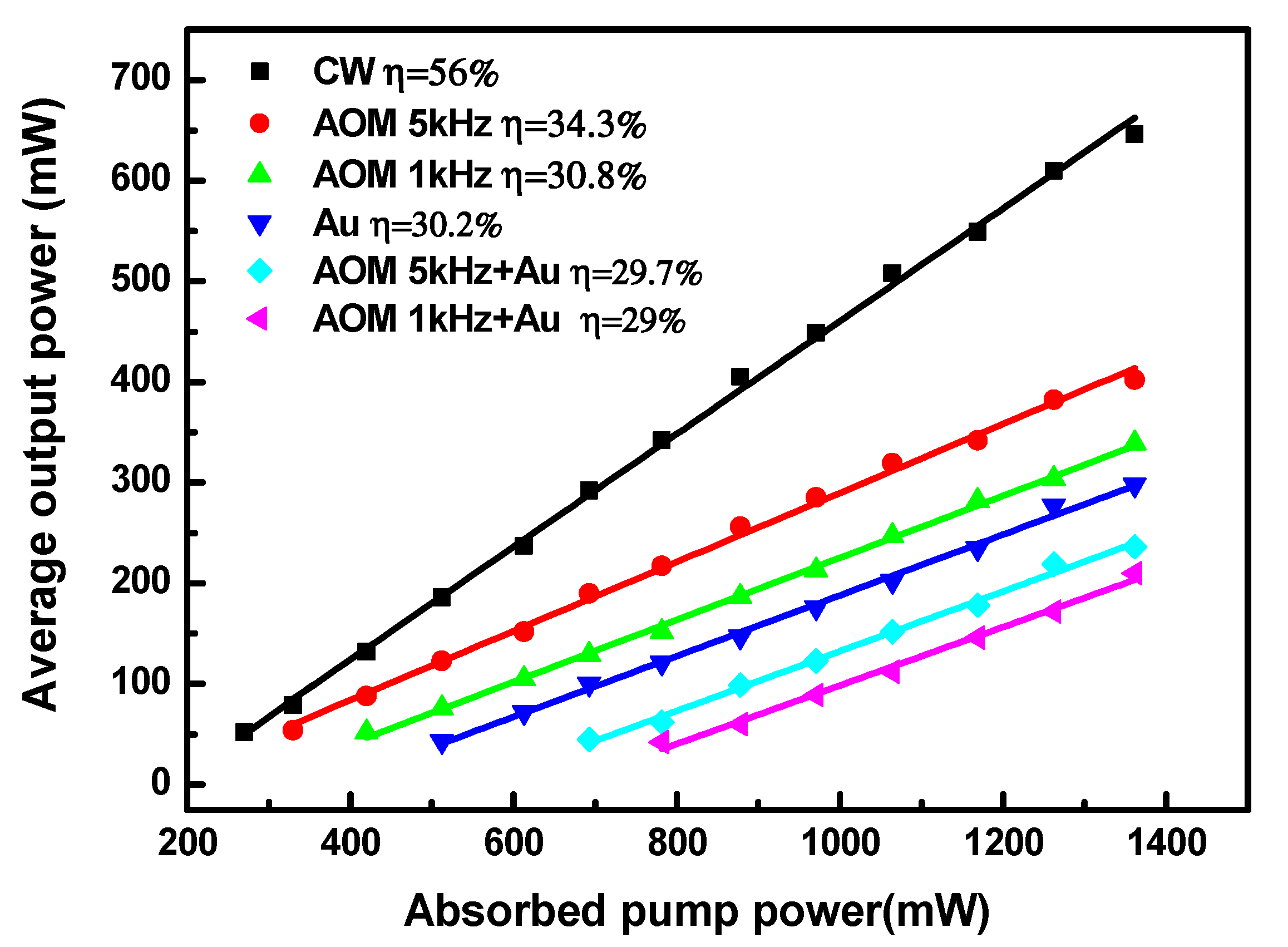
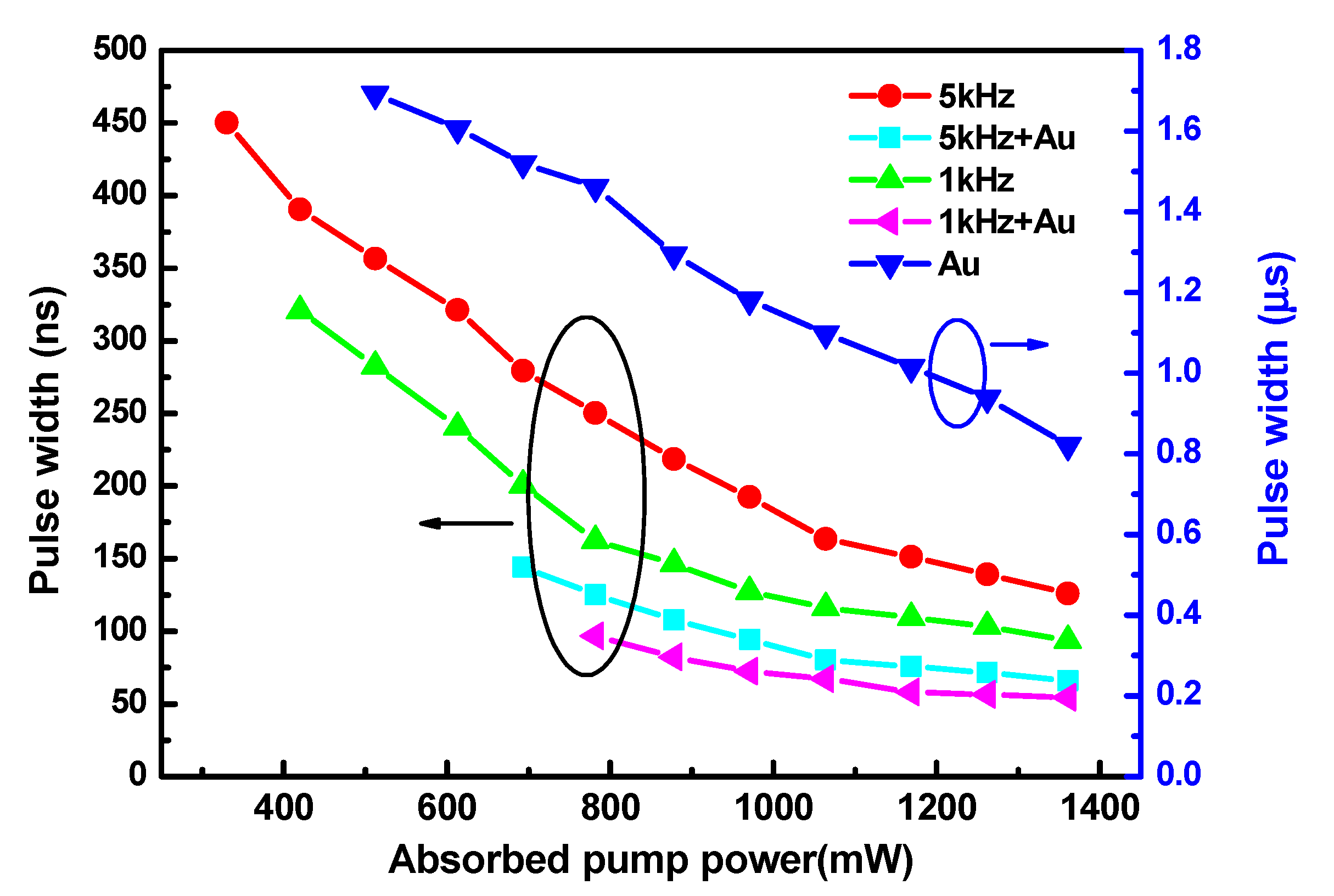
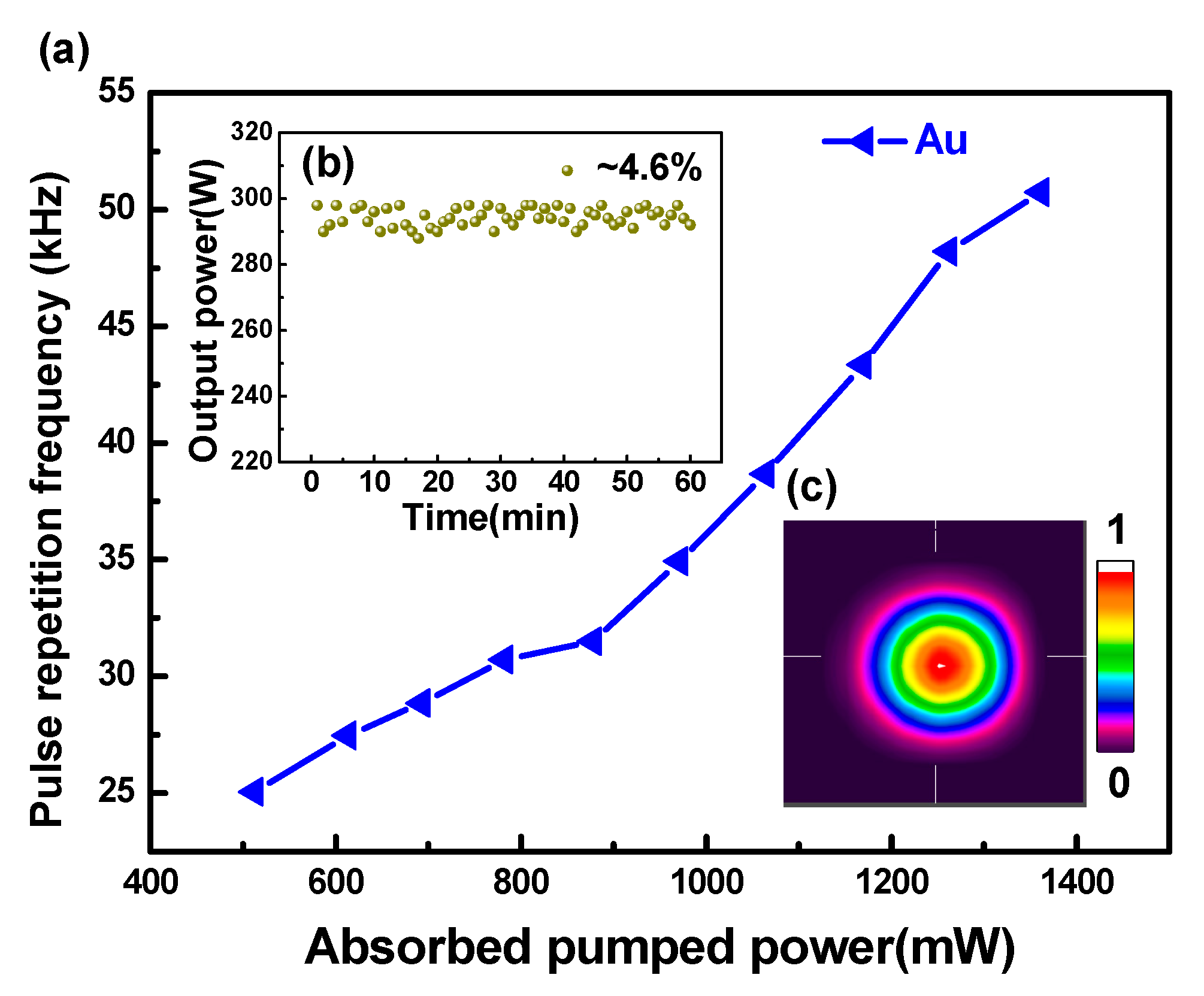
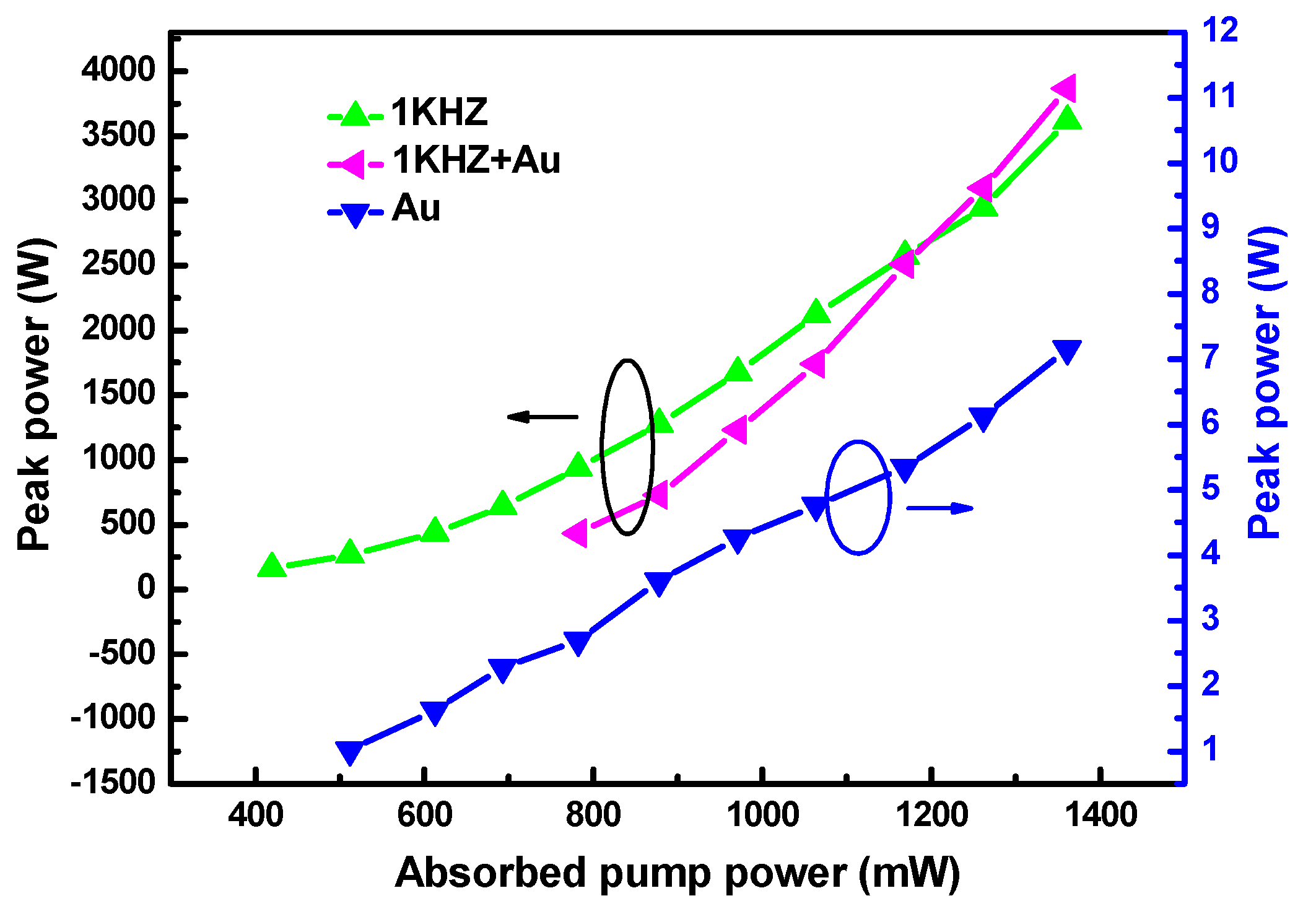

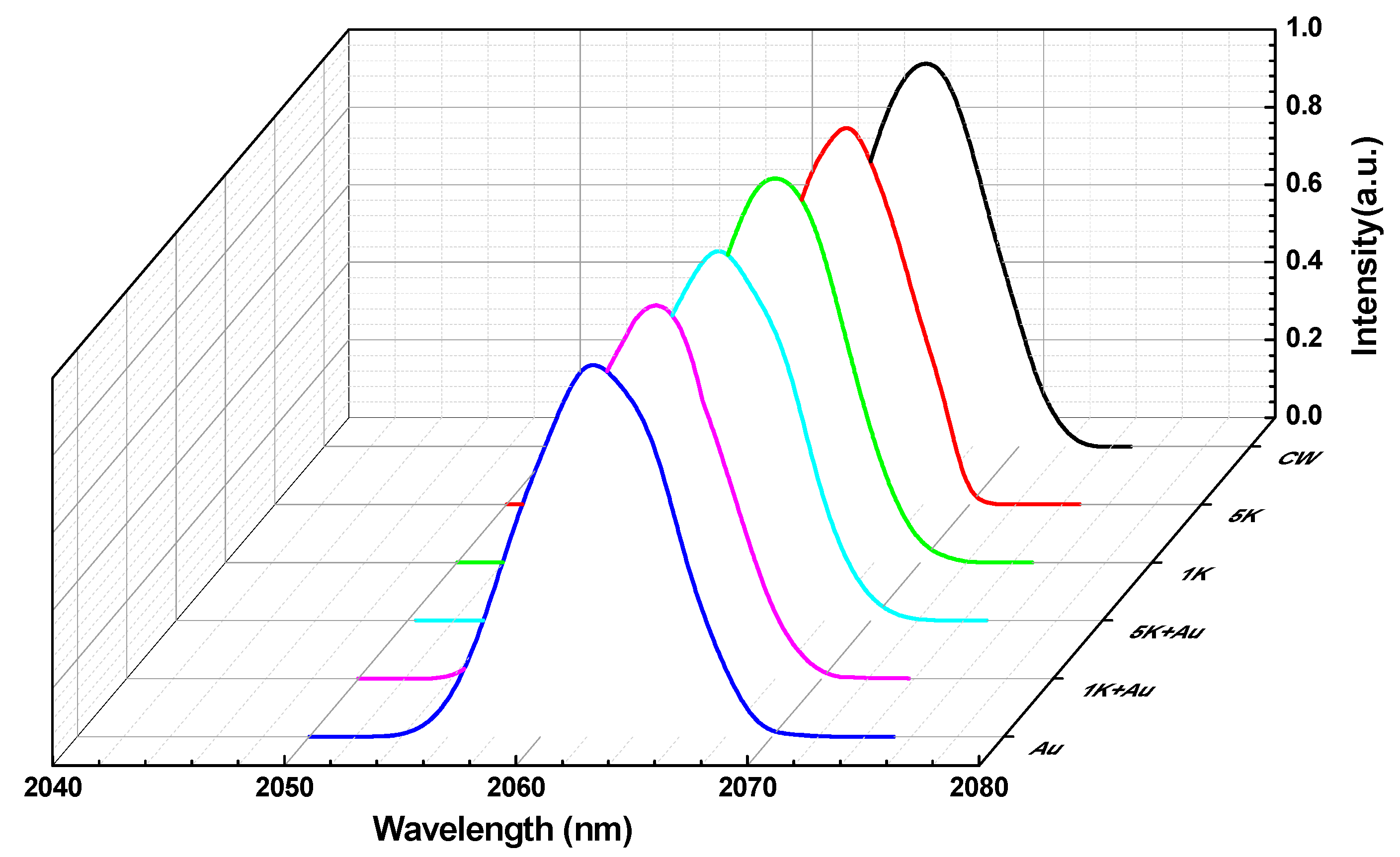
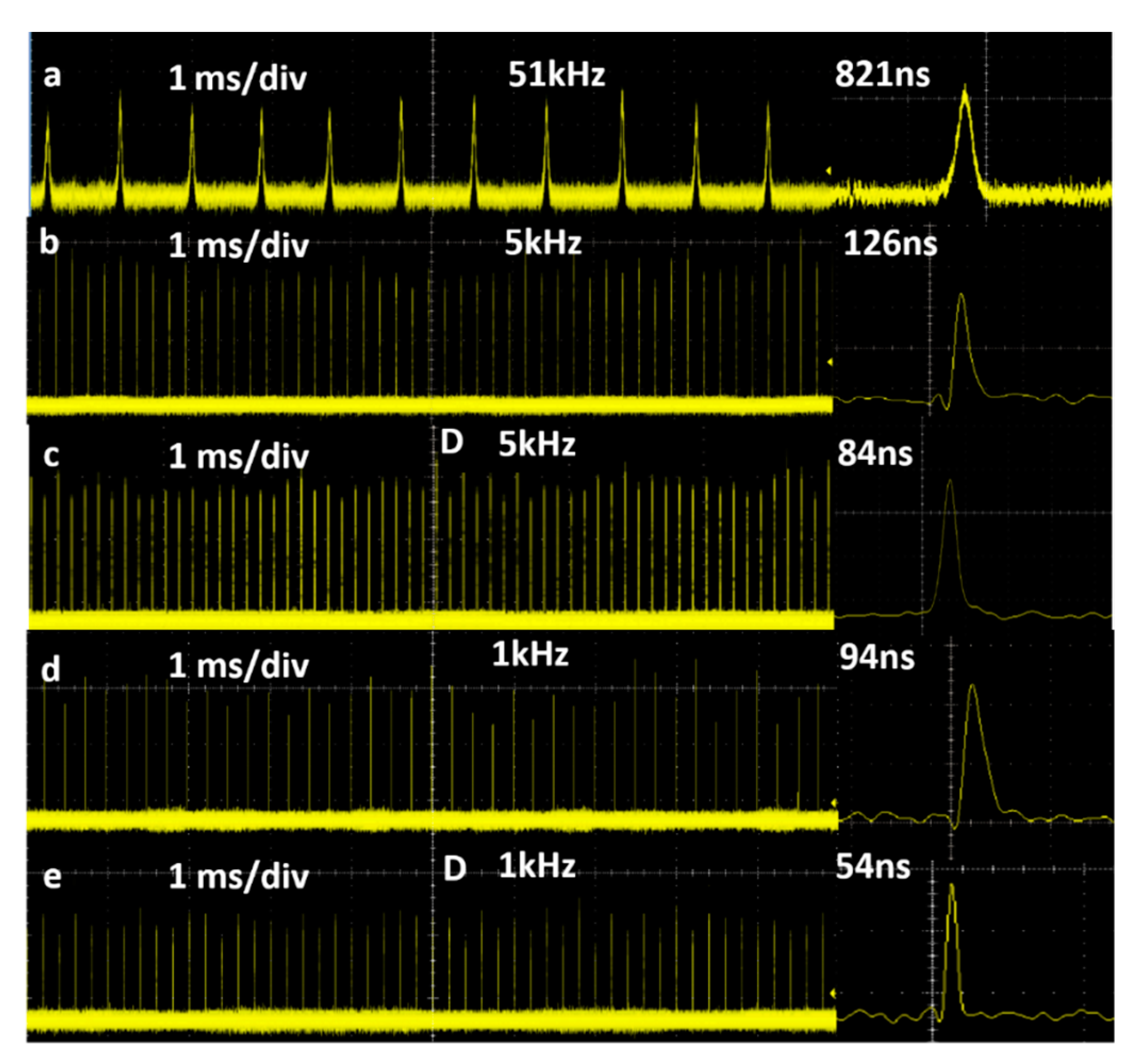
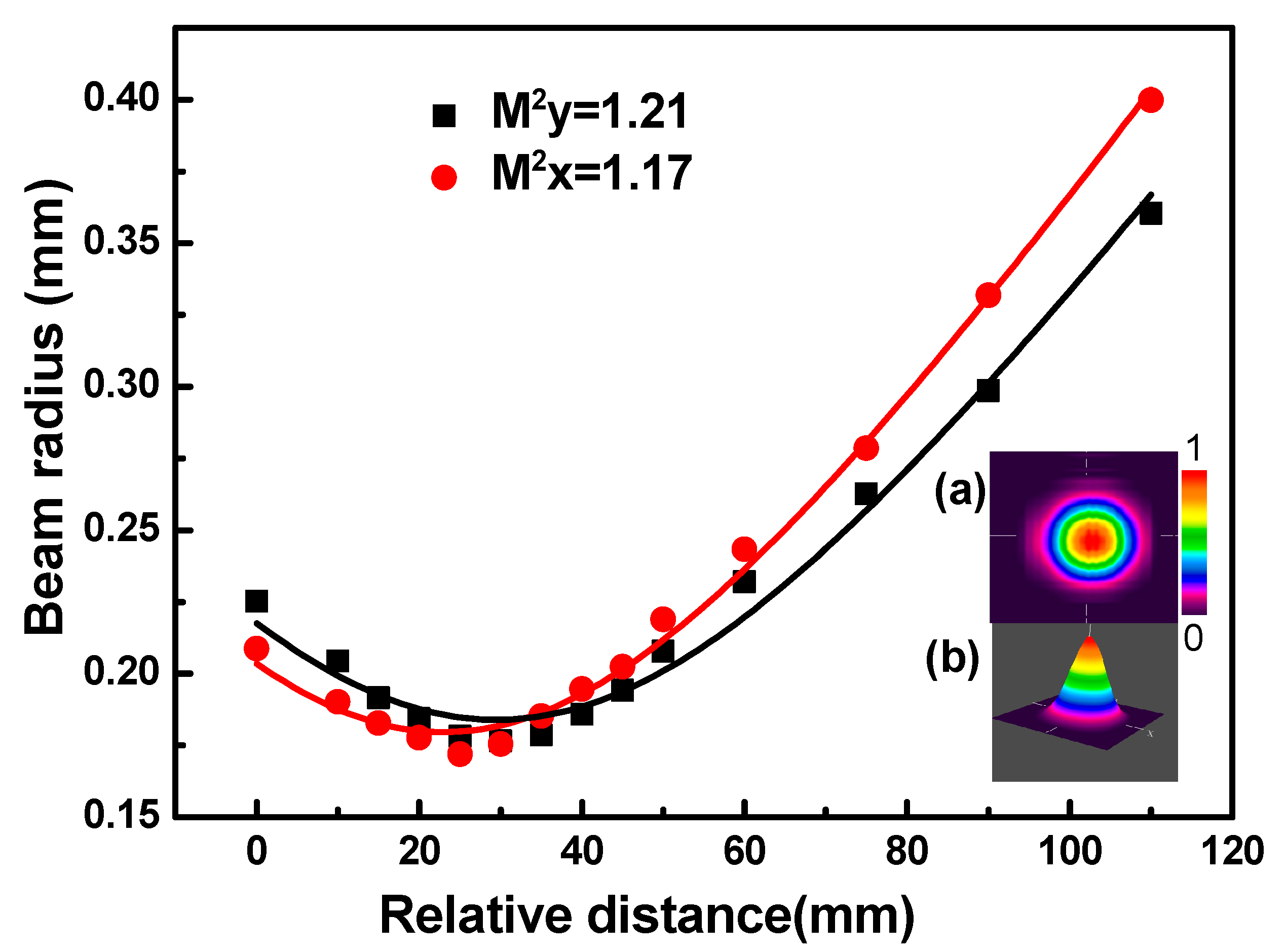
| 2D SA | Gain Medium | Output Power | Pulse Width | Peak Power | tc | Pi | Refs |
|---|---|---|---|---|---|---|---|
| Graphene | Tm:LuAG | - | 170 ns | 3.12 kW | 3.11 | 97.4 | [35] |
| g-C3N4 | Tm:YAP | 274 | 239 ns | 1.15 kW | 4.48 | 241 | [36] |
| WS2 | Tm:Ca(Gd,Lu)AlO4 | 107 | 91 ns | 1.2 kW | 15.38 | 511.3 | [37] |
| MoS2 | Tm:Ca(Gd,Lu)AlO4 | 145 | 82 ns | 0.589 kW | 9.85 | 123 | [38] |
| Au-BNPs | Ho:YLF | 210 | 54 ns | 3.87 kW | 15.2 | 541.3 | This work |
Publisher’s Note: MDPI stays neutral with regard to jurisdictional claims in published maps and institutional affiliations. |
© 2021 by the authors. Licensee MDPI, Basel, Switzerland. This article is an open access article distributed under the terms and conditions of the Creative Commons Attribution (CC BY) license (http://creativecommons.org/licenses/by/4.0/).
Share and Cite
Zhang, C.; Wang, D.; Huang, S.; Yang, J.; Liu, J.; Fang, J. Nonlinear Optical Response of Gold Nanobipyramids for a Doubly Q-Switched Ho-Doped Laser at a Wavelength of 2.1 µm. Nanomaterials 2021, 11, 535. https://doi.org/10.3390/nano11020535
Zhang C, Wang D, Huang S, Yang J, Liu J, Fang J. Nonlinear Optical Response of Gold Nanobipyramids for a Doubly Q-Switched Ho-Doped Laser at a Wavelength of 2.1 µm. Nanomaterials. 2021; 11(2):535. https://doi.org/10.3390/nano11020535
Chicago/Turabian StyleZhang, Cheng, Dongzhou Wang, Shengjun Huang, Jimin Yang, Jie Liu, and Jing Fang. 2021. "Nonlinear Optical Response of Gold Nanobipyramids for a Doubly Q-Switched Ho-Doped Laser at a Wavelength of 2.1 µm" Nanomaterials 11, no. 2: 535. https://doi.org/10.3390/nano11020535
APA StyleZhang, C., Wang, D., Huang, S., Yang, J., Liu, J., & Fang, J. (2021). Nonlinear Optical Response of Gold Nanobipyramids for a Doubly Q-Switched Ho-Doped Laser at a Wavelength of 2.1 µm. Nanomaterials, 11(2), 535. https://doi.org/10.3390/nano11020535






